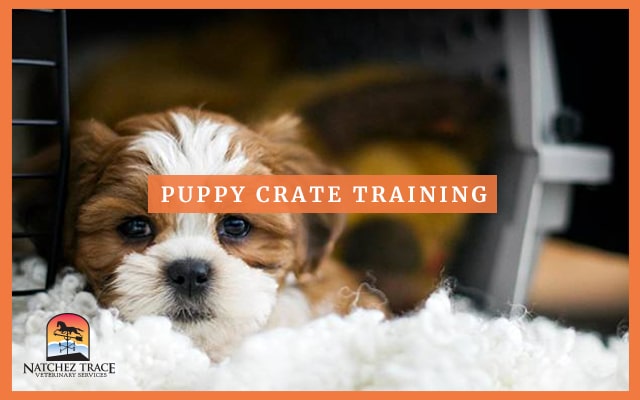Puppy Crate Training Is not Mean–Dogs Love Crates!
Puppy crate training will help your puppy satisfy the “den instinct” inherited from its ancestors. It will become your puppy’s “own private place”–a “security blanket” of sorts.
Puppy crate training also provides guaranteed confinement of your puppy for reasons of security, safety, travel, and housetraining.
Puppy crate training is a great method to create balance and harmony in your puppy’s life. It helps you provide control and structure, rather than sporadic punishment after the fact when trouble has occurred. This eliminates many negative feelings on the part of the owner, and a great deal of stress for the puppy!
Puppy crate training is also an excellent method for house training.
Failure to housebreak a dog is a major reason many dogs eventually end up in the animal shelter! When correctly and humanely used, puppy crate training has many advantages for both you and your puppy!
The Benefits of Puppy Crate Training
Puppy crate training allows you to:
- Enjoy complete peace of mind when leaving your dog at home alone. Nothing can be soiled or destroyed and your puppy is comfortable, protected, and not developing any bad habits.
- Housebreak your dog more quickly by using the close confinement to encourage control, establish a regular routine for outdoor elimination, and to prevent “accidents” at night or when left alone.
- Effectively confine your dog at times when he may be underfoot during such times as during meals, family activities, home repairs, and such.
- Protect your puppy from becoming bothered or over-excited by too much confusion, too many children, or illness.
- Travel with your puppy without risk of the driver being dangerously distracted or the puppy getting loose and hopelessly lost. You also have the assurance that your puppy can easily adapt to strange surroundings as long as it has its familiar “security blanket” along.
Puppy crate training allows your puppy to:
- Enjoy the privacy and security of a “den” of its own. Your puppy will have a safe place to retreat when tired, stressed, or ill.
- Avoid much of the stress, fear and confusion caused by your reaction and punishments to problem behavior.
- More easily learn to control its bowels and to associate elimination only with the outdoors or other designated location.
- Be spared the loneliness and frustration of having to be isolated in the basement, garage or outside away from comfortable indoor surroundings when being restricted or left alone.
- Be conveniently included in family outings, visits, and trips instead of being left behind at home.
Finding the Right Crate for Puppy Crate Training
Getting the right crate is very important! Below are some tips to help you make the best choice.
Crate Cost
Some people balk at the cost of crated. And I know, it can seem expensive. But think about it for a minute.
Even the most expensive dog crate is a bargain when compared to the cost of repairing or replacing a sofa, chair, woodwork, wallpaper, or carpeting!
If you travel with your dog, you may want to get one that is “airline approved.” Getting a crate that is airline approved to begin with will save extra costs later on.
Crate Size
The crate should always be large enough to allow your dog to stretch out flat on its side without being cramped and to sit up without hitting its head on top.
It is always better to use a crate a little too large rather than one a little too small.
Measure your dog from the tip of the nose to the base (not tip) of the tail. Allow for growth by adding approximately 12 inches.
A crate too large can be made smaller by adding a partition of wire, wood, or masonite.
Remember, a crate too large for a young puppy defeats its purpose of providing security and promoting bowel control.
Crate Location
One of the main reasons for using a crate is to confine your dog without making him feel isolated or banished.
Therefore, it should be placed in, or as close to, a “people” area such as the kitchen, family room, etc.
To provide even a greater sense of security and privacy, put the crate back in a corner.
Admittedly, a dog crate is not a “thing of beauty,” but it can be forgiven for not being a welcome addition to the household decor as it proves how much it can help the dog to remain a welcome addition to the household.
We put our crate in the corner beside the couch, covered it with a nice looking tablecloth, and use it as an end-table.
Tips for Crate Training Your Puppy
Now that you have a great crate, you’re ready to begin training your puppy!
Below are some tips to help you successfully train your puppy.
Tips for puppy crate training:
- A young puppy (8-16 weeks) should have no problem accepting a crate as his “own place.” Any complaining done at first is not caused by the crate, but by the puppy learning to accept the controls of its new environment. The crate will actually help it adapt more easily and quickly to its new world.
- Place the crate in a “people” area, like the kitchen or living room. Make sure it is in a spot free from drafts and not too near a direct heat source.
- Use an old towel or piece of blanket that can be easily washed for bedding.
- Place a freshly worn unlaundered article of your clothing such as a t-shirt to comfort your puppy with your scent.
- Avoid putting newspaper in or under the crate. The smell of newspaper sometimes encourages elimination.
- Do not put food or water in the crate. Puppies should not be fed in the crate and the water will be spilled.
- Make it clear to all family members that the crate is not a playhouse. It is meant to be a “special room” for the puppy. The puppy’s rights should be recognized and respected!
- Get the puppy accustomed to letting you reach into the crate at any time. This will teach your puppy not to become overprotective of the crate.
- Immediately implement a “crate routine . Close the puppy in it at regular intervals during the day using its nap times to guide you. Make sure to crate the puppy when it must be left alone for up to 3-4 hours.
- Give your puppy a chew toy for distraction while in the crate.
- Remove your puppy’s collar and tags. These could get caught in an opening and cause problems.
- The puppy should be shown no attention while in the crate. Showing attention to the puppy while in the crate can cause the puppy to believe that whining and crying will get it more attention.
- The puppy should be taken outside last thing every night before being put into the crate. Once in the crate for the night, the puppy should stay there until first thing in the morning.
- When removing the puppy from the crate, IMMEDIATELY take it to the chosen area for bowel eliminations.
- Always feed the puppy early enough to allow ample time for bowel elimination before it is time to place the puppy in the crate. This can be up to one hour, depending on the puppy. Simply clock the time after eating until the bowel movement occurs to determine what the time interval for your particular puppy.
- After 8-12 weeks the puppy should be fully house trained. At this point, you can leave the crate door open (or take it off) and allow the puppy to come and go as it chooses. If the puppy becomes destructive during its growing phases, confine it to the crate when it is not under your supervision.
Don’t worry or weaken if things don’t go smoothly at first.
Be consistent and firm!
Remember, you are doing your puppy a huge favor…
You are giving it a “den of its own” and helping it stay out of trouble!
Need some help with your puppy? Contact us!








